
Claire
7 year old Claire attends for her first eye examination with her mother.
Her date of birth is 01/02/2016.
- DV including board at school, TV and playing outside reports seeing well.
- NV including reading, writing and tablet use reports seeing well.
- Doing well in school, no concerns with parents and nothing noted by teacher.
- No reports headaches, sore or tired eyes.
- POH None.
- FOH None. No ametropia, strabismus, amblyopia or astigmatism.
- GH Good. No medication.
Unaided Vision:
- RE: 6/6 and N4 at near
- LE: 6/6 and N4 at near
Refraction:
- RE: +0.25
- LE: 0.00
OMB: Orthophoria distance and near
NPC: To nose
Amp. Of Accom. : 15D binocularly
Enter Claire's basic information into mEYE™ Guide.
Q. What do you think her personalized report will show?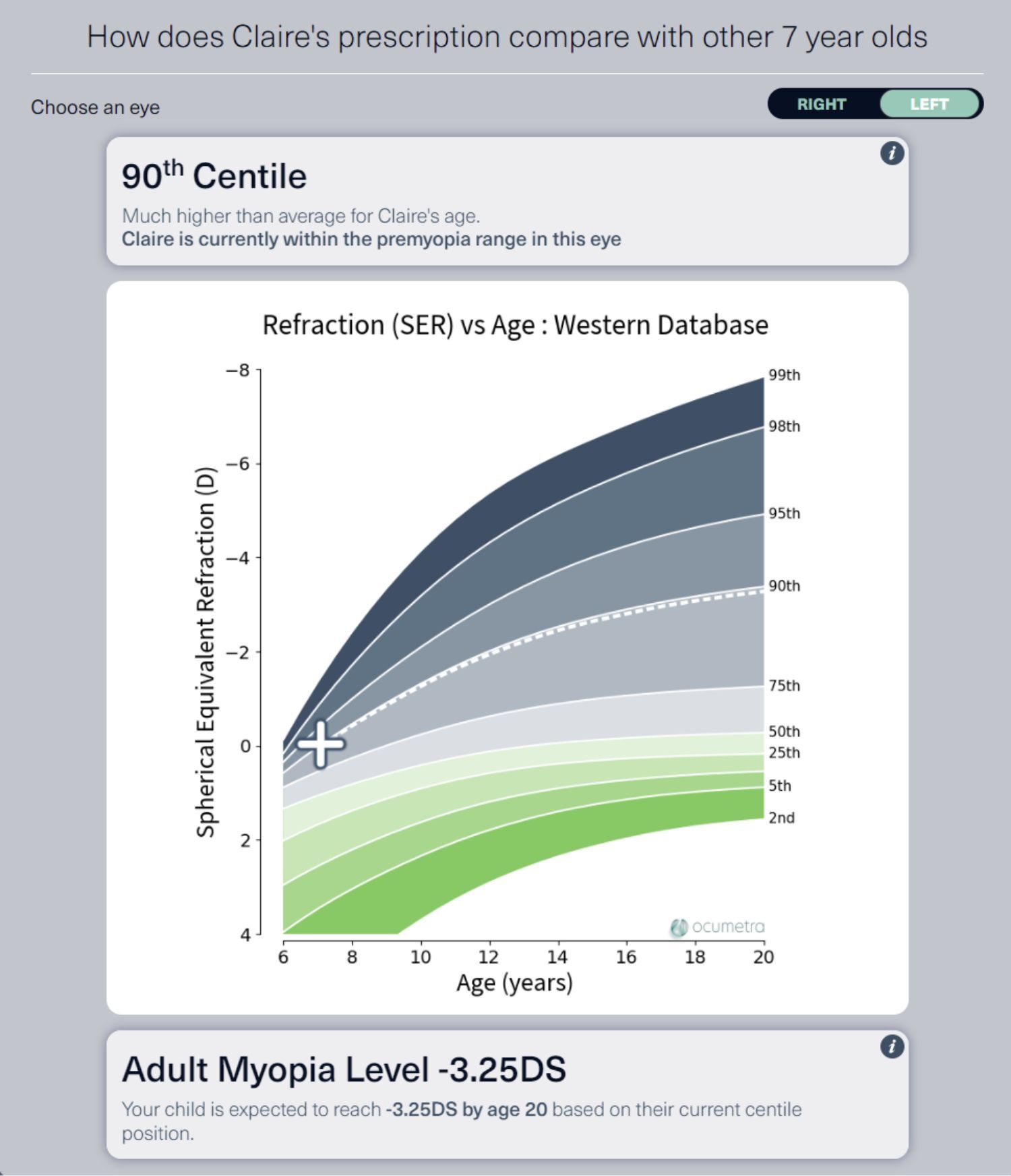
Does this result surprise you?
What advice would you give Claire and her parents?
Which aspects of the report do you think are the most relevant for Claire?
Claire has been identified as a pre-myope, her refraction at this age is one of the most significant risk factors for her developing myopia in the future.
From Claire's personalized report it may be most relevant to discuss;
- Claire's centile graph so that Claire and her Mum understand Claire's risk.
- Highlight 'What else can we do,' to educate Claire and her Mum about the importance of lifestyle habits that can help delay and reduce the risk of myopia onset.
Every report is specific to each individual. In certain cases, such as pre-myopes you may not need to discuss every section of the report, only what you think is relevant.
Claire and her Mum will leave with a copy of the report on their personal device, so should they need to remind themselves about lifestyle recommendations or should they wish to read more about future treatment options, they have all the information to hand.
This early education supports Claire's eye health and provides the foundation for future conversations on myopia management if required.
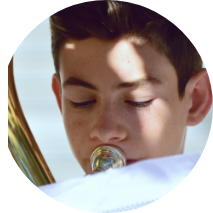
Sean
10 year old Sean attends for his annual eye examination.
His date of birth is 01/01/2013.
- Reports that the board at school is slightly more difficult to see, finds himself squinting and doesn't think his spectacles are as 'good' as what they were when he first got them.
- NV including reading, writing and tablet use reports seeing well.
- No reports headaches, sore or tired eyes.
- POH Low myope.
- FOH Mum myopic ( -2.00ish BE) No strabismus, amblyopia or astigmatism.
- GH Good. No medication.
- No myopia management currently.
VA with current spectacles:
- RE: 6/9 and N4 at near
- LE: 6/9-2 and N4 at near
Today's refraction:
- RE: -1.25/-0.50 x 80
- LE: -1.50 /-0.25 x 90
K readings:
- RE: 7.47/7.43mm
- LE: 7.40/7.45 mm
OMB: Orthophoria distance and near with current Rx
NPC: To nose
Amp. Of Accom. : 15D binocularly
Enter Sean's basic information into mEYE™ Gauge.
Q. What do you think his estimated axial length will be? Q. Do you think Sean has a low or high risk of future myopia progression?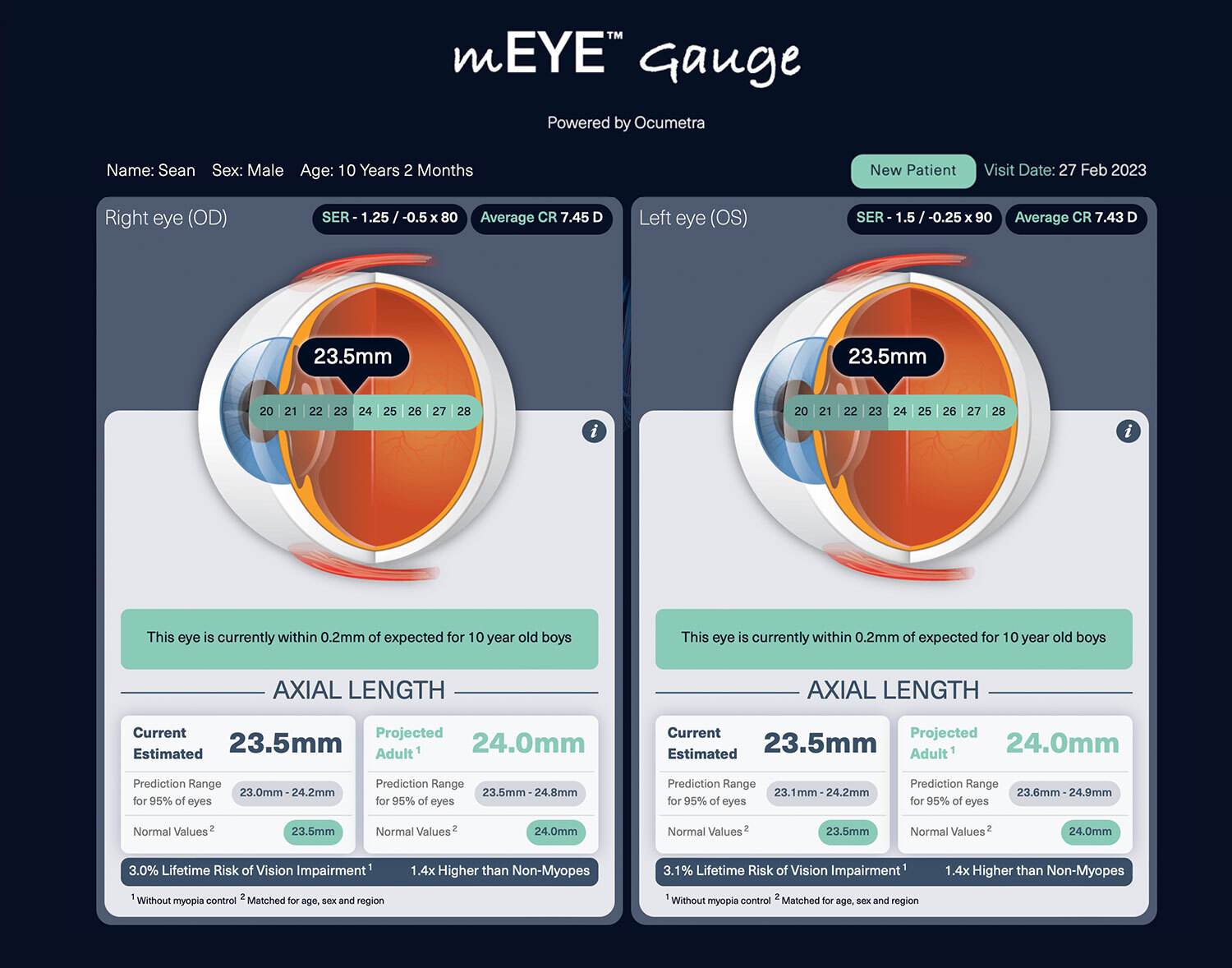
Does this change how you think about Sean's risk of future myopic change?
What is the relevance of Sean's projected adult axial length?
- Sean's estimated axial length is within 0.2mm of that expected for his age and sex.
- This data provided by mEYE™ Gauge contributes additional information about Sean's myopia associated risk. It utilizes the additional keratometry information to show you how his axial length compares to other children of the same age and sex.
- Axial myopes are the primary target group for myopia management intervention. Sean essentially has a normal axial length currently but should be monitored.
- Even though Sean is a low myope, he is still at risk of future progression and has a slightly elevated risk of vision impairment based on his predicted adult value without treatment.
Enter Sean's basic information into mEYE™ Guide
Q. What do you think his personalized report will show?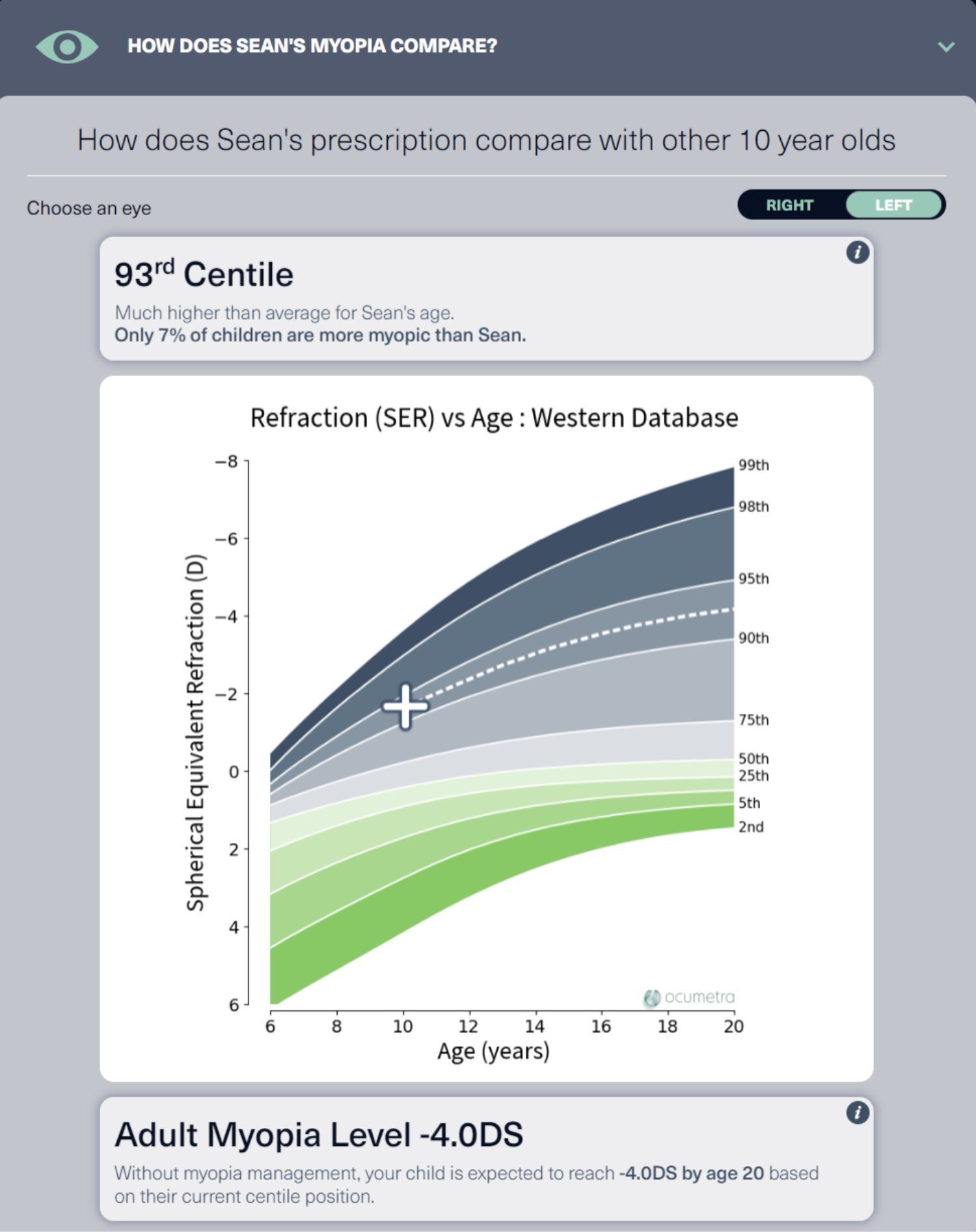
Does this result surprise you?
How would you explain these results to Sean's parents?
Which aspects of the report do you think are the most relevant for Sean?
Sean's personalized report places him on the 93rd Percentile and his predicted adult myopia level is -4.00DS.
A low myopic prescription does not always mean a low risk of progression. By plotting a child's prescription on mEYE™ Guide's centile graph you also calculate their predicted adult myopia level.
In Sean's case we can see that regardless of his low myopia and age he remains at higher risk for future progression and thus vision impairment associated with axial elongation. This is further supported with the additional information of his predicted axial length.
From Sean's personalized report it may be most relevant to discuss;
- Sean's centile graph in combination with his estimated axial length so that he and his parents can understand his risk.
- You can easily illustrate to Sean's parents what his unaided vision could be in the future without myopia management with the vision simulator.
- You can illustrate to Sean and his parents the short- and long-term benefits of myopia management with the risk indices.
- Treatment section can support your recommendation and preferred treatment methods.

Niall
Niall (7 years old) is Sean's younger brother, he has also attended for his annual eye examination.
His date of birth is 12/12/2015.
- No current spectacles.
- DV 'seems fine'. Not aware of any problems.
- NV including reading, writing and tablet use reports seeing well.
- No reports headaches, sore or tired eyes.
- POH Normal.
- FOH Mum myopic ( -2.00ish BE) No strabismus, amblyopia or astigmatism.
- GH Good. No medication.
Unaided Vision:
- RE: 6/6 and N4 at near
- LE: 6/6 and N4 at near
Today's refraction:
- RE: plano / -0.25 x 90
- LE: plano
K readings:
- RE: 8.45/8.43mm
- LE: 8.43/ 8.40mm
OMB: Orthophoria distance and near
NPC: To nose
Amp. Of Accom. : 15D binocularly
Enter Niall's basic information into mEYE™ Gauge.
Q. What do you think his projected axial length will be? Q. Do you think his risk profile will be similar to that of his older brother?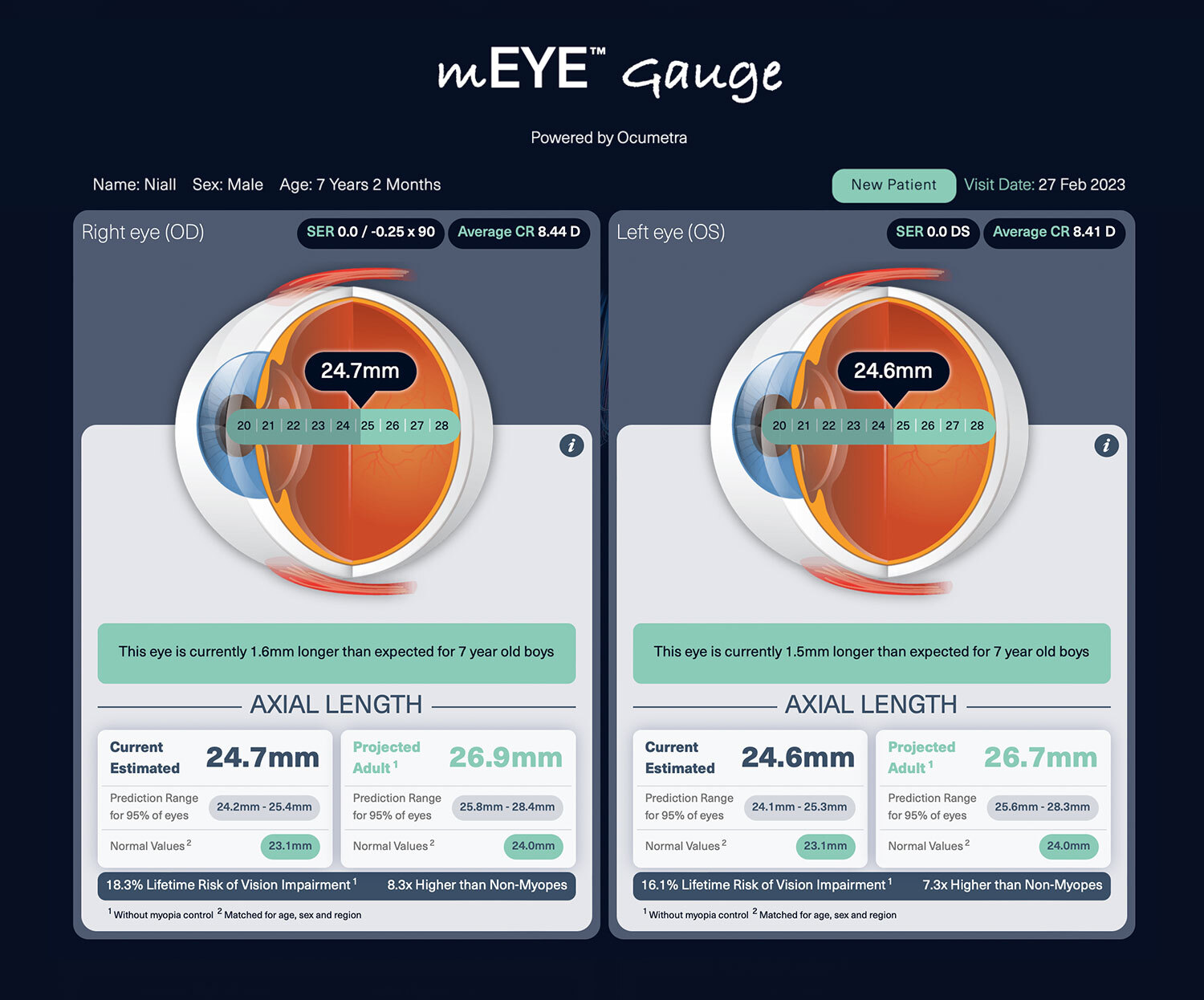
Does this change how you think about Niall's risk of future myopic change?
Would you say he has a low or high risk for future myopia progression?
Does this knowledge alter your management of Niall?
- Niall has a different risk profile to that of his brother and his predicted axial length is 1.5mm longer than expected for 7 year old males.
- This data would suggest that Niall's risk of future progression is higher than that of his brother, despite being a pre-myope.
Enter Niall's basic information into mEYE™ Guide
Q. What do you think his personalized report will show?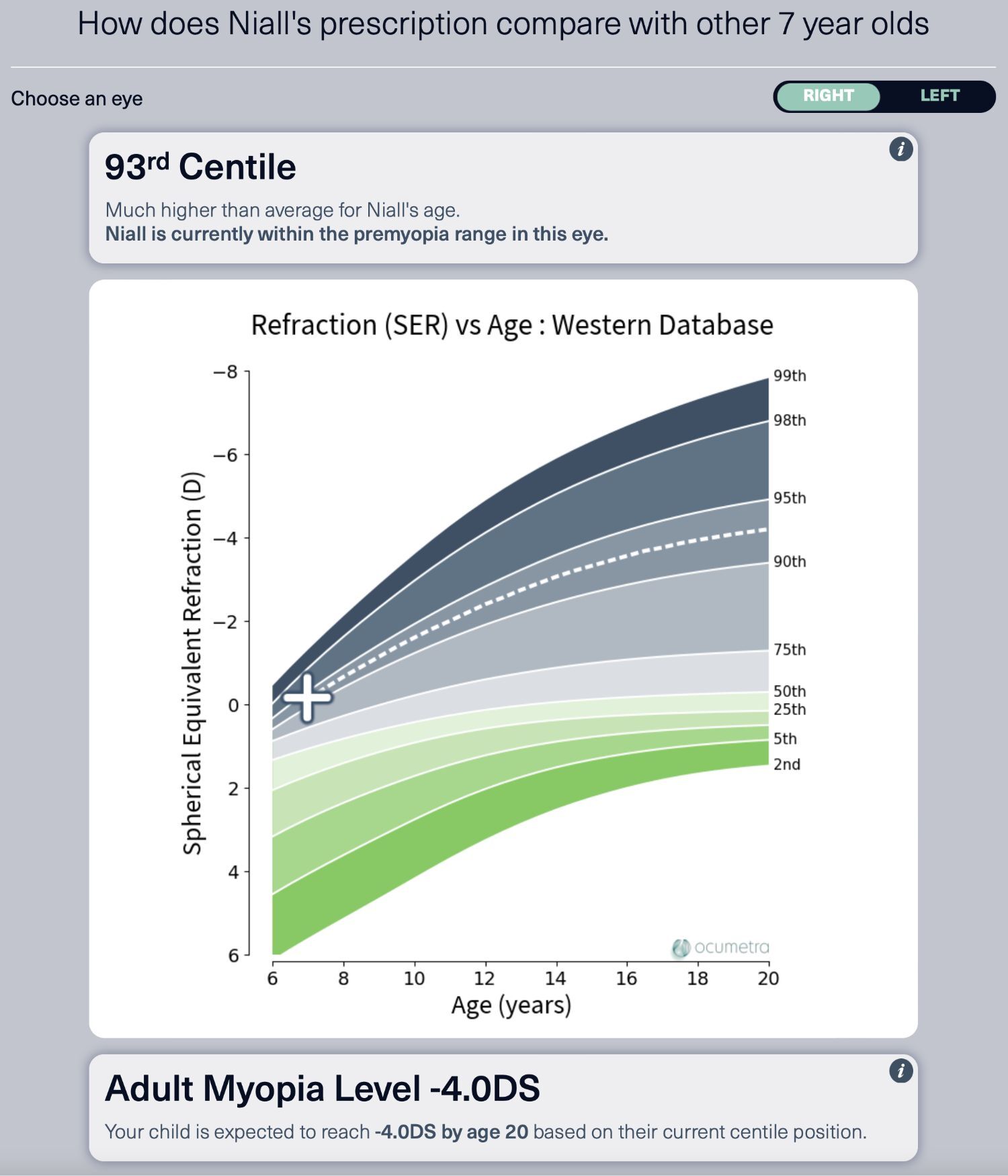
Does this result surprise you?
How would you explain Niall's myopia to him and his parents?
What action will you take?
Both brothers are on the 93rd percentile and their predicted myopia level is -4.00DS, even though Niall is not currently myopic. His younger age means he is likely to progress more than Sean over the coming years and reach the same adult refraction.
The mEYE™ Guide report alone identifies Niall's risk of future progression and his case highlights how the addition of axial length information from mEYE™ Gauge can provide a more accurate picture of his future myopic risk.
mEYE™ Guide and mEYE™ Gauge outputs can be combined to explain how Niall's myopia risk differs to that of his brother despite having the same refractive centile and prediction, and hence why management for both is important.
- mEYE™ Guide can be used to help identify premyopes, where parent education about myopia and lifestyle advice can be most beneficial. mEYE™ Guide can be used with every child to identify their myopia risk.
- Early education on myopia and myopia management provides the foundation for future conversations about treatment if required, thus increasing the uptake of myopia management. By plotting a child's prescription on mEYE™ Guide's centile graph you also calculate their predicted adult myopia level.
- Low myopia does not always mean low risk of future progression, both Sean and his brother Niall are true examples of that. Despite Sean and Niall being similar in age and having a fairly similar prescription, their projected adult axial length differs by more than 3mm in each eye. Niall has an approximately 6 times greater risk of vision impairment in his lifetime due to his longer axial length.
- Their case highlights why the incorporation of axial length estimation is a valuable asset for understanding which children are most at risk and which could benefit most from treatment.